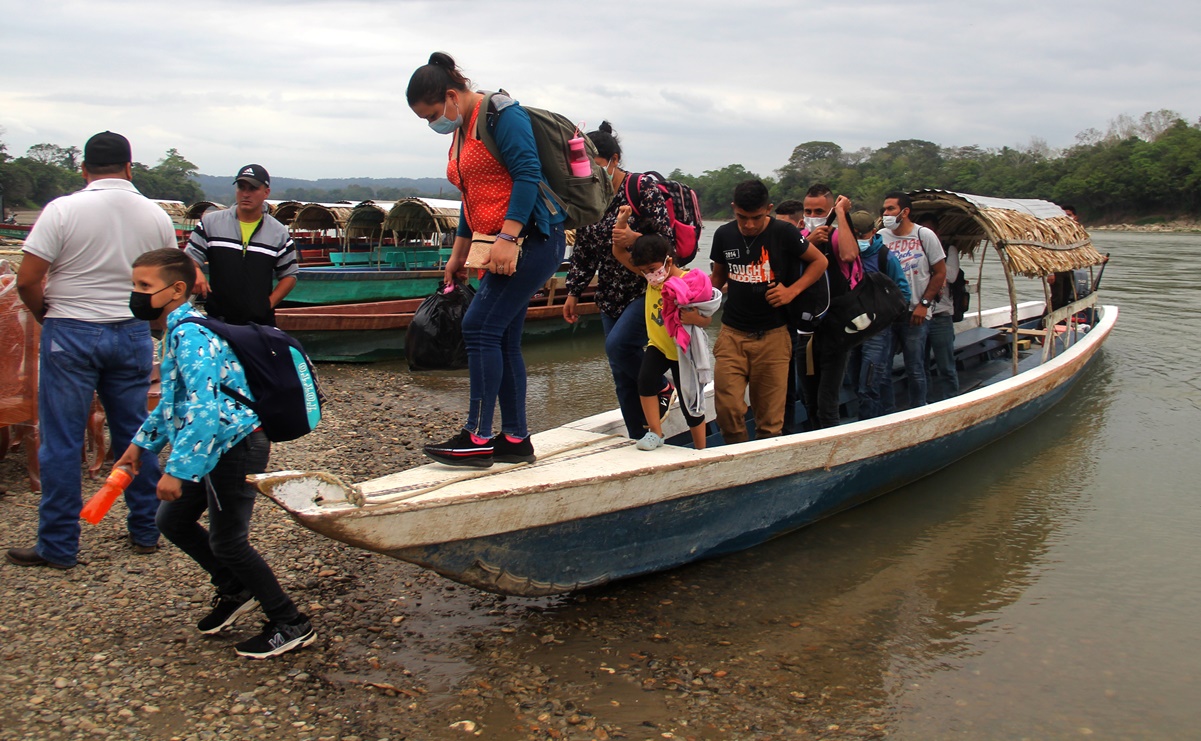
Corozal border.- In the middle of the howl of the monkeys and the song of the birds, tens of Central American migrants they cross irregularly daily a Mexican territory aboard boats through the Usumacinta river, Which serves as a political division between Mexico and Guatemala, A place where, until the weekend, there was none sanitary filters nor security.
While the federal government reinforces the presence of elements of the National Institute of Migration (INM) and the National Guard (GN) in Tapachula and the bank of the river Suchiate, the migrants enter national territory without anyone stopping them, more than 560 kilometers to the northeast, between the Lacandona Forest.
In this border, located to 165 kilometers of the municipal head of Palenque already almost two kilometers of the archaeological zone of Yaxchilán, navigating by the Usumacinta river – most mighty of Mexico and longest of Central America– the arrival of boats loaded with young people and women carrying their minor children from Honduras, Guatemala and the Savior.
It also reads: Border agents release undocumented migrants for trial detained in US: NBC News
This route is being used by human traffickers and migrants traveling on their own, due to the lack of surveillance by the INM, the National Guard and the Mexican Army.
During a tour last Saturday it was observed that dozens of migrants arrive, from Guatemala, to the town known as La Técnica, where they board the boats that cross them by the river to Frontera Corozal, belonging to the municipality of Ocosingo .

On the Mexican side, the traffickers have already hired local taxi drivers to transport people to safe houses. Foreigners traveling on their own are stripped of little money they carry for alleged Guatemalan police, as payment for not being arrested and repatriated in their countries of origin.
They have to walk, for up to seven days, along the side of the road and in stretches between the jungle, to Palenque, their first destination.
At this border point, between the Montes Azules Biosphere Reserve and the Serra de l’Lacandon National Park, until last weekend the government had not deployed personnel to prevent the passage of undocumented migrants, as was done in Tapachula in the framework of the restrictions that began on March 19, with a validity of 30 days, to contain the entry of migrants. The presence of health personnel was also not reinforced to enforce the health protocols imposed by the pandemic from’ Covid-19.
It also reads: They arrest 95 Central American migrants who tried to cross Mexico as tourists
In this area the risk is not that they are stopped by migration, but by snakes and jaguars.

Among the foreigners are women traveling with their children and minors.
With free passage
The border points with Guatemala del Ceibo, in Tenosique, Tabasco, as well Corozal border and Meritorious of the Americas, in Chiapas, These are the routes used by traffickers and migrants. Until last Saturday they were without surveillance from any federal corporation; only local authority review checkpoints are observed.
Between howls of monkeys swaying in giant trees and singing of different birds, such as the quetzal, parrots, spoons and parrots of different varieties, small caravans of migrants, who have no money to pay for transportation, walk the Lacandona forest, Jaguar Territory.
Along the road between Frontera Corozal and Palenque, groups of foreigners are observed walking day and night.
Antoni, Daniel and Jairo are a group of 12 young Hondurans who have been walking for three days. They ask for some water and food to move on. They estimate that they will arrive in Palenque in four more days.
It also reads: They rescue 53 Central American migrants in Veracruz
They look tired. They say they try to walk a bit at night, but are afraid of being attacked by snakes or some jaguar, as there are caution warnings to be feline area.
Indigenous chol and lacandons who inhabit the region point out that they observe the passage of migrants daily, many of them asking for shoes, food and water.
After walking 165 kilometers, men and women take a break at the municipal head of Palenque. Some stay at the Jtatic Samuel Ruiz hostel. Last Friday, half a thousand migrants were observed resting around the site.

for Tabasco
Admission by Tenosique, Tabasco, It is no less hard. From this side it was possible to observe that the foreigners enter national territory by blind spots of the border the Taronger, Guatemala-El Ceibo, Mexico, walking a distance of 64 kilometers by the line of railroad and marshy pastures, under temperatures of more of 36 degrees.
After a walk of four to five days, the migrants make a rest stop at the hostel La 72, Located in Tenosique, to then continue its journey to Palenque, where they will continue their journey to the border with the United States, by the route that crosses the states of Veracruz and Tamaulipas. The hardest part is yet to come.